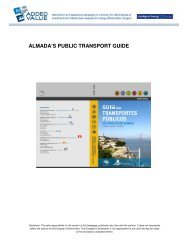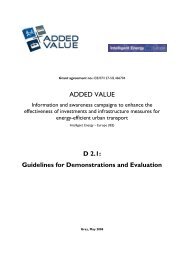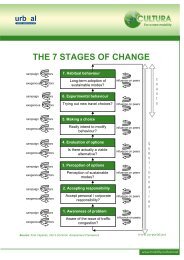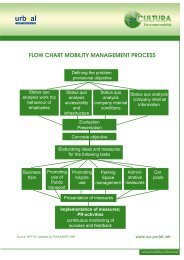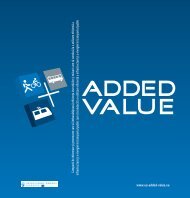SUMO - Eltis
SUMO - Eltis
SUMO - Eltis
Create successful ePaper yourself
Turn your PDF publications into a flip-book with our unique Google optimized e-Paper software.
26<br />
There are many different types of data collection methods:<br />
• Individual studies<br />
• Site studies<br />
• Documentation<br />
• Calculations.<br />
The choice of data collection method is dependent on the type of data of interest.<br />
Several different types of method can be used and the most common division is that<br />
one separates qualitative and quantitative methods. The methods are used to answer<br />
different types of questions.<br />
Qualitative methods are used to acquire a deeper understanding of an occurrence. These<br />
can also be used to gain insight ahead of a quantitative study. Qualitative studies could<br />
be focus groups and in-depth interviews where the result cannot be used for quantitative<br />
descriptions.<br />
Quantitative studies are carried out to gain statistically reliable results. This could be<br />
through questionnaires, telephone surveys or private interviews etc. Questionnaires are<br />
a popular method, often without sufficient knowledge on the part of the user.<br />
Experience and knowledge is necessary to draw up a good questionnaire. For larger studies,<br />
at least one pilot study should be carried out before the real study.<br />
One special type of quantitative study is a travel habits survey, used to describe travel<br />
for a group of people. This material can be used to produce a wealth of different data.<br />
If the necessary expertise is lacking, then we recommend that a professional market research<br />
firm is used. Experience from the MOST project indicates that this produces<br />
better survey data.<br />
7.3 INDICATORS AND METHODS FOR THE <strong>SUMO</strong> ANALYSIS LEVELS<br />
Overall goals for environmental and road safety projects are usually to reduce emissions<br />
and reduce the number of people killed and injured in traffic. Direct measurement of<br />
these targets is difficult and takes a long time. Using <strong>SUMO</strong> for measurements at a<br />
number of early stages in the project can provide valuable information as the project<br />
progresses.<br />
sumo – System for Evaluation of Mobility Projects<br />
Examples of data that could be necessary for monitoring and<br />
evaluation of the Test Traveller project<br />
– Number of contacted companies<br />
– Number of people at the companies that are aware of the project<br />
– Number of people that have attended information meetings<br />
– Number of people attending information meetings satisfied with the information<br />
– Number of people that have applied to become test travellers<br />
– Number of people that actually become test travellers<br />
– Travel patterns for test travellers before the test<br />
– Number of test travellers satisfied with the test<br />
– Number of test travellers that continue to use public transport after the project



